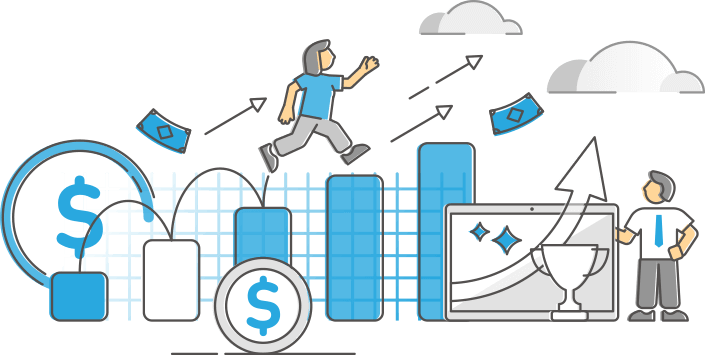
Click the button to start reading
Getting Started with Bottom Up Estimating – Your Essential Guide
If you’re a project manager, then you know that estimating the cost is essential to the success of any project.
After all, how can you plan and budget for a project if you don’t have a good sense of how much it’s going to cost?
There are a number of different methods that project managers can use to estimate the cost of a project, but in this blog post, we’re going to focus on one in particular: bottom up estimating.

DEFINED – Bottom Up Estimating
Bottom up estimating is a technique that involves breaking down the work required for a project into smaller, more manageable pieces—known as work packages—and then estimating the cost of each individual work package.
This type of estimate is usually more accurate than other types (such as top-down estimating), but it can be more time-consuming and resource-intensive.
Still, if done correctly, bottom up estimating can give you a much better sense of the true cost of your project—which is why we recommend it.
5 Amazing Benefits of Bottom Up Estimating
Now that we’ve explained the basics of bottom up estimating, let’s take a moment to discuss some of the reasons why you might want to use this type of estimate for your next project.
Benefit #1 – It’s Accurate.
No doubt about it, bottom up estimating is more accurate than top down estimating.
Since you’re breaking the project down into smaller pieces and then estimating the cost of each individual piece, you’re able to account for all the small details and unknowns that can often make top down estimates inaccurate.
Benefit #2 – It Leads to More Efficiency
Another advantage of bottom up estimating is that it often leads to more efficiency. That’s because you’re able to identify inefficiencies early on and then address them before they become a bigger problem.
Benefit #3 – It Forces You To Pay Attention To Detail
As we mentioned before, bottom up estimating is more resource-intensive than top down estimating.
But that’s not necessarily a bad thing. In fact, some people would argue that it’s actually a good thing.
That’s because this type of estimate forces you to pay attention to detail—which can only be a good thing for your project.
Benefit #4 – It Can Help You Make Better Decisions
Bottom up estimating can also help you make better decisions. That’s because you’re able to see the big picture and the small details at the same time.
This type of estimate gives you a complete view of your project—which can be very helpful when it comes time to make decisions.
Benefit #5 – It’s Flexible
Finally, bottom up estimating is flexible. That’s because you can adjust the level of detail (i.e., the number of work packages) to fit your needs.
If you need a more accurate estimate, you can break the project down into more work packages.
Or if you need a quick estimate, you can break the project down into fewer work packages.
The bottom line is that bottom up estimating is a very versatile tool—and one that every project manager should have in their toolkit.

Cons of Bottom Up Estimating
While bottom up estimating has many advantages, it’s not without its drawbacks. In this section, we’ll discuss some of the main drawbacks of using this type of estimate.
CON #1 – It’s Time-Consuming
Do you remember the old adage, “good things come to those who wait?” Well, that’s definitely true when it comes to bottom up estimating.
This type of estimate can be very time-consuming—especially if you’re working on a large project. That’s because you need to take the time to break the project down into smaller work packages and then estimate the cost of each individual work package.
So if you’re working on a tight deadline, bottom up estimating might not be the best option.
CON #2 – It’s Resource-Intensive
As we mentioned before, bottom up estimating is more resource-intensive than top down estimating. That’s because you need to have a good understanding of the project in order to break it down into smaller pieces.
Still, we believe that the benefits of bottom up estimating outweigh the drawbacks. And in the next section, we’ll lay out several benefits in more detail.
CON #3 – It’s Not Always Necessary
Another drawback of bottom up estimating is that it’s not always necessary. In some cases, top down estimating might be just as effective—and a lot less time-consuming.
So before you invest the time and resources into bottom up estimating, make sure it’s really necessary for your project.

When to Use Bottom Up Estimating
Now that we’ve discussed some of the advantages and disadvantages of bottom up estimating, you might be wondering when to use this type of estimate.
In general, we recommend using bottom up estimating when accuracy is more important than speed. That’s because bottom up estimating can be very accurate—but it’s also very time-consuming.
So if you need a quick estimate, top down estimating might be a better option. But if you need a more accurate estimate, bottom up estimating is probably the way to go.
How to Do Bottom Up Estimating: A Step-By-Step Guide
Now that we’ve talked about what bottom up estimating is and why it’s so useful, let’s take a look at how to actually do it. Here are the steps you’ll need to follow:
STEP 1 – Break down your project into smaller work packages.
Big chunks of work can be overwhelming—and difficult to estimate. That’s why the first step in bottom up estimating is to break your project down into smaller work packages.
How? Start by identifying all of the tasks that need to be completed in order to finish your project. Then, group these tasks into smaller work packages.
For example, let’s say you’re working on a website redesign. Some of the tasks you’ll need to complete include wireframing, designing, and coding. These could be grouped into three different work packages:
Wireframing: This work package includes all of the tasks related to creating the wireframes for the new website.
Designing: This work package includes all of the tasks related to designing the new website.
Coding: This work package includes all of the tasks related to coding the new website.
STEP 2 – Create a work breakdown structure.
Once you’ve identified all of the work packages for your project, it’s time to create a work breakdown structure (WBS).
A WBS is a tool that helps you to organize and track the progress of your project. It’s basically a hierarchy of all the work that needs to be done, from the highest level (the project itself) down to the lowest level (individual tasks).
EXAMPLE
Here’s an example of what a WBS might look like for our website redesign project:
I. Website Redesign Project
A. Wireframing
1.) Wireframe 1 -> Page 1 – Homepage
2.) Wireframe 2 -> Page 2 – About Us
3.) Wireframe 3 -> Page 3 – Contact Us
B. Designing
1.) Design 1 -> Page 1 – Homepage
2.) Design 2 -> Page 2 – About Us
3.) Design 3 -> Page 3 – Contact Us
C. Coding
1.) Code 1 -> Page 1 – Homepage
2.) Code 2 -> Page 2 – About Us
3.) Code 3 -> Page 3 – Contact Us
As you can see, the WBS is organized into three levels. The first level is the project itself (website redesign). The second level is the work packages (wireframing, designing, and coding). And the third level is the individual tasks (wireframe 1, wireframe 2, etc.).

STEP 3 – Estimate the effort required for each task.
Now that you have your project broken down into smaller work packages, it’s time to start estimating the effort required for each task.
To do this, you’ll need to consult with the people who will be doing the work. Ask them how long they think it will take to complete each task.
For example, if you’re estimating the time required to design a new homepage, you might ask the designer how long it will take them to create the design. They might say it will take 8 hours.
Once you have an estimate for each task, you can then add up all of the estimates to get an estimate for the work package as a whole.
So, using our example from above, if the design work for the homepage will take 8 hours, and the design work for the About Us page will take 6 hours, then the total estimated effort for the Designing work package will be 14 hours.
STEP 4 – Add up all of the estimates to get an estimate for the entire project.
Once you’ve estimated the effort required for each task, you can then add up all of the estimates to get an estimate for the entire project.
Again, using our example from above, if the total estimated effort for the Wireframe work package is 20 hours, and the total estimated effort for the Designing work package is 14 hours, and the total estimated effort for the Coding work package is 10 hours, then the total estimated effort for the entire project will be 44 hours.
STEP 5 – Add a contingency to account for uncertainty.
As with any estimate, there’s always going to be some uncertainty. Things might take longer than expected, or there might be unforeseen problems that arise.
To account for this, you’ll need to add a contingency to your estimate. A contingency is an amount of time (or money) that’s set aside to deal with unexpected problems.
For example, you might decide to add 10% to your total estimated effort as a contingency. So, using our example from above, the total estimated effort for the project would now be 44 hours + 10% contingency, or 48.4 hours.
The amount of contingency you add will depend on the level of uncertainty surrounding the project. If there’s a lot of uncertainty, you might want to add a larger contingency. If there’s relatively little uncertainty, you might be able to get away with a smaller contingency.
Once you’ve added a contingency, you should have a good estimate for the total effort required to complete the project.

Conclusion
Bottom Up Estimating is a great way to get an accurate estimate for your project. By breaking down the project into smaller tasks, and then estimating the effort required for each task, you can get a good sense for how much work and money is involved.
















